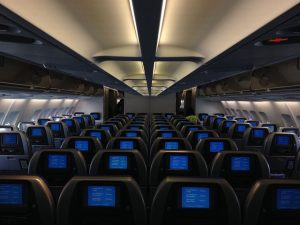 Airplane cabins don’t consist entirely of recycled air. Depending on the type of airplane, it may only recycle about half of this air. The other half consists of fresh air. Being that cabins are pressurized — and, therefore, sealed — you might be wondering how they get fresh air. Passengers can’t open windows to allow fresh air to enter the cabin. If there’s a breach in the cabin, such as an open window, the cabin will lose pressure. So, how do airplanes can get fresh air for the cabin?
Airplane cabins don’t consist entirely of recycled air. Depending on the type of airplane, it may only recycle about half of this air. The other half consists of fresh air. Being that cabins are pressurized — and, therefore, sealed — you might be wondering how they get fresh air. Passengers can’t open windows to allow fresh air to enter the cabin. If there’s a breach in the cabin, such as an open window, the cabin will lose pressure. So, how do airplanes can get fresh air for the cabin?
The Basics of Airplane Cabin Air
Most airplanes get fresh air from their jet engines. Like automotive engines, the jet engines used in airplanes require air. They can’t burn fuel alone to generate power. Rather, they require a combination of fuel and air. When exposed to a spark, these two elements will combust, thereby generating power that propels the airplane through the air.
When air enters an airplane’s engines, it’s compressed. Some of this air then enters the engines’ combustion chambers where it’s burned. The air that doesn’t go into the combustion chambers, however, is routed to the airplane’s cabin. The compressed fresh air travels to the airplane’s air conditioning unit where it’s cooled, after which it’s released through the vents.
Why Airplanes Use a Mixture of Fresh and Recycled Air
As previously mentioned, airplanes use a mixture of both fresh and recycled air for the cabin. They need fresh air specifically to regulate humidity levels. Airplane cabins already have dry air with a low humidity level. Research shows that most airplane cabins have a relative humidity level of about 20%. In comparison, experts recommend maintaining a humidity level of about 40% to 50% in your home.
If they only used recycled air, airplanes would have even drier cabin air with a lower humidity level. The use of fresh air adds moisture vapor to the cabin, thereby raising its humidity level. Cabins still have dry air, but the air would be much drier if it consisted entirely of recycled air. The air outside of airplanes is more humid than the cabin air.
Secondly, the use of fresh air helps to minimize airborne pollutants. Germs can spread inside airplane cabins. Although they use filters, germs can still float through the cabin. Pumping fresh air into the cabin helps to reduce the transmission of germs and other pollutants. The old air is released and replaced with fresh air.



